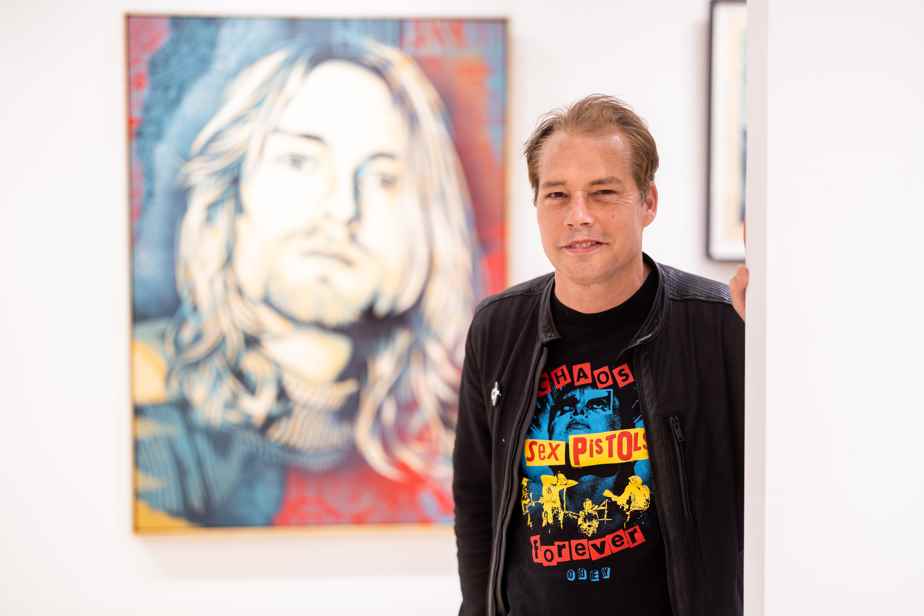Posted at 11:00 a.m.
A luminary of urban art, Shepard Fairey is, at 52, a prominent member of the worldwide fraternity of muralists, while at the same time pursuing a solid career in the art market. He has lost none of his talent, if we judge by the work recently produced south of Prince-Arthur Street, which speaks of justice, war and violence, with firearms. current topics.

Photo ROBERT SKINNER, THE PRESS
With his assistants, Shepard Fairey took three days to create his mural.
This is the second time the artist has set foot in Montreal. He had come at the age of 26 with his parents. Do you visit Montreal every 26 years? he was asked. “I hope to come back before I turn 80! he replies, laughing. In 1996, we mostly walked around Old Montreal. I had placed some stickers in the streets! My parents thought it was immature and vandalism. Now they say they changed their minds, but I don’t think that’s true! »
Shepard Fairey has done murals in Toronto and Vancouver. He wanted to come back to Montreal and Adam Vieira, artist and co-owner of the S16 gallery, had been trying for nine years to bring the – very busy – artist, who nevertheless took advantage of his time at S16 to paint a work there. in the entrance.
-

photo provided by the artist
The artist working on a facade
-

PHOTO PROVIDED BY THE ARTIST
Shepard Fairey at work
1/2
His works are small graphic jewels in old-fashioned tones that are his signature. Follower of Andy Warhol, Barbara Kruger and Keith Haring, but also heir to Dadaism and Marcel Duchamp – by his non-conformism – he creates neat prints and mixed techniques, mixtures of stencil work, screen printing and collages, in particular scraps of articles.
-

PHOTO PROVIDED BY THE ARTIST
Modular Speech 22022, mixed media on paper, 27.25 x 27 in
-

PHOTO PROVIDED BY THE ARTIST
AR-15 Lily (1/10), 2022, silkscreen and collage on paper, 41 x 30 in
-

Photo Dominick Gravel, LA PRESSE
Detail of Kurt Cobain – Endless Nameless, V.2made this year as a tribute to the singer of Nirvana from a photo taken by photographer Naomi Petersen
-

photo provided by the artist
Artwork criticizing hydraulic fracturing, an environmentally damaging gas extraction technique
-

Photo Dominick Gravel, LA PRESSE
Some serigraphs on metal
1/5
Obey, as he is nicknamed, is a phenomenon. Coming from the world of skateboarding, he anchored his fame when his design Hopedevoted to Barack Obama, became an unofficial poster for his 2008 presidential campaign. Since then, Shepard Fairey has continued to create works imbued with his soul as a pacifist and activist for just causes.

PHOTO PROVIDED BY THE ARTIST
The poster Hopedirected by Shepard Fairey
Despite his brilliant international career, he never turned his back on his youthful principles. His works criticize the mistakes of our time. War, American democracy in danger, the damage of guns, the oil, gas and mining industries, the horrors of capitalism, our unconsciousness vis-à-vis the environment, sexism, racism, homophobia . That’s a lot, he said.
“It’s as if I was still dealing with the same problems of humanity over and over again with a slight change in the way of speaking about them”, observes Shepard Fairey, who says he is depressed by the situation. “But art is good therapy. In order to leave some room for hope, he uses slogans such as “Rise Above” or associations such as a flower and a gun. He draws lotuses, “those flowers that grow in the mud”, doves, signs of justice and peace, hence the title of the exhibition.

Photo Dominick Gravel, LA PRESSE
View of part of the exhibition
Today, he is collected by the greatest museum institutions on the planet, from the Victoria and Albert Museum in London to the Smithsonian’s National Portrait Gallery in Washington, via the Museum of Modern Art (MoMA) in New York.
Despite the success, the artist does not give in to ease or cynicism. “You should never become cynical. Times are cyclical. The best in man always ends up taking over. I try to communicate to people the taste for… communicating rather than being spectators. With street art, prints, stencils, we can express ourselves. People have more power than they think. I want to democratize art, but also communication. »
The exhibition peace and justice is presented at the S16 gallery, in Westmount, until July 3.

